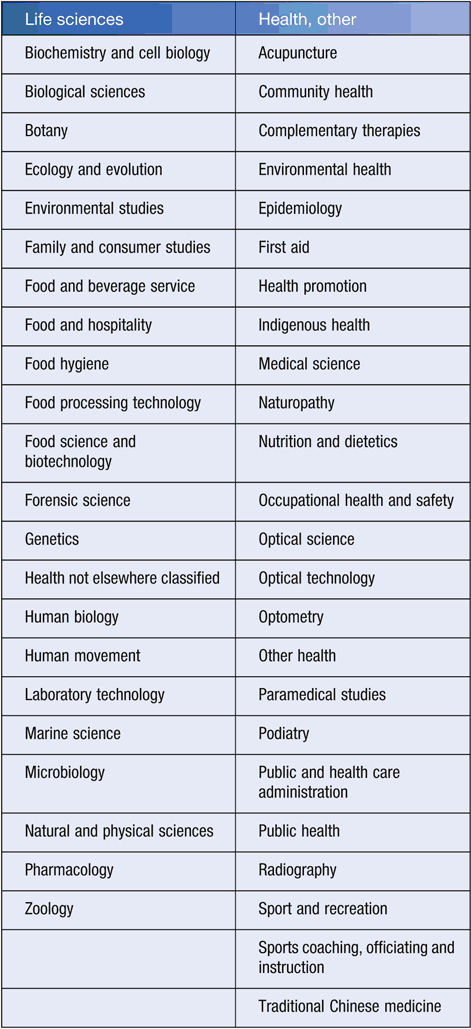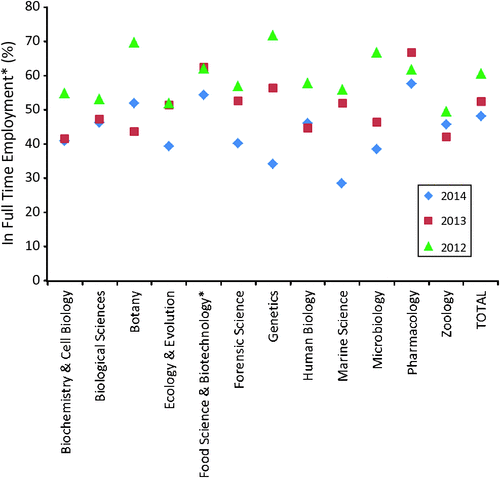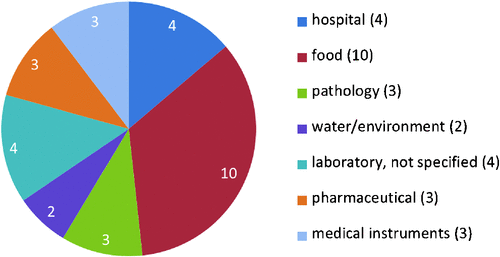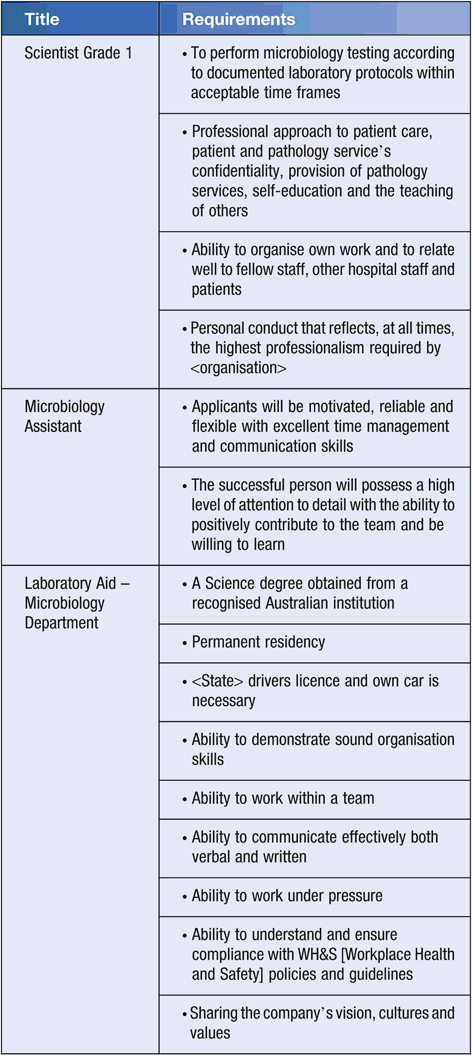Graduate employment trends in the life sciences: implications for microbiology educators
John V Smith A , Danilla Grando B and Nina Fotinatos CA School of Engineering, RMIT University, Melbourne, Vic., Australia. Tel: +61 3 9925 1298, Fax: +61 3 96390138, Email: johnv.smith@rmit.edu.au
B School of Science, RMIT University, Melbourne, Vic., Australia. Tel: +61 3 9925 7135, Fax: +61 3 99257110, Email: danilla.grando@rmit.edu.au
C Centre of Learning Innovation Professional Practice, Federation University Australia. Tel: +61 3 5327 9145, Email: n.fotinatos@federation.edu.au
Microbiology Australia 37(2) 56-59 https://doi.org/10.1071/MA16027
Published: 18 April 2016
Graduates in the Life Sciences, including microbiology have experienced similar employment trends to graduates in other fields over the past 30 years. Recent downward trends in graduate employment levels have raised concerns among educators and the community in general. Awareness of the diverse opportunities for graduates of microbiology is needed. For many, explicit education in ‘employability skills’ is also considered to be needed to enable graduates to succeed in the competitive job market.
Graduate employment in Australia, as measured by annual surveys approximately four months after graduation show a dramatic deterioration from 2009 to present. This deterioration occurred in two stages, the initial impact of the Global Financial Crisis followed by relatively little change in 2011 and 2012 then further drops in 2013 and 2014. The most recent data (2015) shows little change from 2014 (Figure 1).
While medicine and pharmacy appear immune from the impacts, close viewing of the data indicate that even those fields have been impacted negatively in recent years. The category ‘Health, Other’ has tracked the trend of ‘All Graduates’ since around year 2000. The category of ‘Life Science’ has ranged between 10% to 20% below the ‘All Graduates’ trend, over most of the 30 years of data available. The 10% difference is evident in times of better employment and the 20% more evident in times of poor employment (Figure 1).
Microbiology is classified as part of the Life Science category (Table 1). It is however unknown how many graduates who are employed by pathology companies self-identify in the category of Health Other as medical scientists rather than the category of Life Sciences. When the employment data for the fields within Life Science are separated it can be seen that there is a wide variety of results (Figure 2). In 2012, microbiology had higher employment outcomes within the Life Sciences but fell to the lower part of the group as the lowest overall results were recorded in 2013 and 2014 (Figure 2). This may be a reflection that Microbiology is becoming a more inter-disciplinary science, with students graduating with Molecular Biology, Biotechnology and Biomedical degrees. Concerns have been expressed that ‘microbiology is becoming a less distinct discipline within universities’1. This article reviews the recent data and briefly identifies some issues for education practices.

|

|
Entry-level microbiology jobs
Graduate employment data indicates that gaining employment is more difficult for graduates at the current time than it has been over the past 30 years. Nevertheless, the field of microbiology employs graduates in many diverse roles1. A brief survey of advertised positions, conducted by the authors for the purpose of this review, showed many varied roles where a degree in microbiology was a prerequisite or seen as desirable (Figure 3). The key requirements tend to be similar and three of these positions are summarised in Table 2. The advertised prerequisites, include a wide range of personal attributes such as ‘attention to detail’ and ‘willingness to learn’.

|

|
Implications for microbiology education
Graduates of microbiology degrees have been affected, along with most other graduates, by a prolonged downturn in the level of employment in the field soon after graduation. The competition they face to obtain employment in the field is great. It is likely that the expectations of the graduate, and those who may have supported them through their studies, is also great2.
If this is the case then educators in microbiology, and Life Sciences more broadly, need to ensure that they are preparing their students for greater success in transitioning to a career. Prinsley and Baranyai3 found that employers in Australia rate graduates of STEM (Science, Technology, Engineering and Maths) as poor in intercommunication skills and time management. A key challenge for discipline educators is dealing with the divergent views on how these skills could and should be acquired. It also begs the question to what extent and in what ways should university education prepare students to compete for the limited number of jobs available in the field and is it their role?
A review of what employers are looking for (such as Table 2) shows that the desired attributes of graduates is broad. Many of these attributes such as ‘professionalism’, ‘ability to work in a team’ or ‘ability to communicate’ are likely to correspond with the aspirations of many university learning and teaching charters. However, the extent to which these attributes or skills are explicitly taught or assessed is likely to be highly variable. The style of teaching that underpins microbiology in a university context is heavily influenced by the experience of the educator and the academic freedom within the program/degree structure4. Where the educator lacks previous industry experience, this may also have an impact on the style and focus of the teaching curriculum, pedagogy, chosen learning and teaching strategies and establishment of an appropriate learning environment suitable to the field of microbiology.
It is also essential to acknowledge that while the university degree or diploma qualifications and practical experiences (within formal classes or otherwise) are valuable in gaining employment in the field other factors also influence opportunities in the market. The number of positions in the field are also influenced by the varying rates of retirements in both the public and private industries, the inevitable increased use and impact of automation, centralisation of microbiological services, value of networking within the industry related events and alignment between the skills and knowledge to vacant positions.
Previous contributions to microbiology education include engagement of learning and work5,6 and use of game-based learning7. Contributions have also been made toward specifically addressing employability skills within curriculum8–11. There is need for further research and debate on how the field of microbiology can best educate graduates and improve their interpersonal communication skills and time management. Students need to be able to describe their ‘microbiologist identity’ and curriculum should ensure that there are plenty of opportunities to experience, develop and ultimately communicate the importance of a microbiology career12. Within the university context, educators can also be guided by information easily accessible in reliable textbooks/e-textbooks and the Australian Learning and Teaching Council (ALTC) Science Standards13.
Conclusion
The record of graduate employment suggests that the Life Sciences including Microbiology has experienced the same general trends as other fields of study in Australia over the previous 30 years. That includes the recent ‘graduate employment crisis’ which appears to be a residual effect of the global financial crisis. The general trend appears to be toward lower rates of graduate employment – at least within the 4 months after graduation. Many educators including in the Life Sciences and Microbiology see incorporation of ‘Employability’ into curriculum to be one approach to improving outcomes – or at least enabling some graduates to outcompete others in a limited job market. That job market may also be artificially limited by not recognising the diverse range of employment opportunities for graduates with microbiological training. The opportunities are not only health-related and include diverse roles in environmental and biosecurity protection, food manufacturing and service and pharmaceutical development and manufacture.
References
[1] Redfern, J. et al. (2015) What is a microbiologist? A survey exploring the microbiology workforce. FEMS Microbiol. Lett. 362, fnv208.| What is a microbiologist? A survey exploring the microbiology workforce.Crossref | GoogleScholarGoogle Scholar | 26534895PubMed |
[2] http://www.theglobeandmail.com/news/national/education/the-expectation-gap-students-and-universities-roles-in-preparing-for-life-after-grad/article21187004/?page=all
[3] Prinsley, R. and Baranyai, K. (2015) STEM skills in the workforce: what do employers want? Office of the Chief Scientist, Canberra.
[4] Åkerlind, G.S. (2007) Constraints on academics’ potential for developing as a teacher. Stud. High. Educ. 32, 21–37.
| Constraints on academics’ potential for developing as a teacher.Crossref | GoogleScholarGoogle Scholar |
[5] Hills, J.M. et al. (2003) Bridging the gap between degree programme curricula and employability through implementation of work-related learning. Teach. High. Educ. 8, 211–231.
| Bridging the gap between degree programme curricula and employability through implementation of work-related learning.Crossref | GoogleScholarGoogle Scholar |
[6] Schliephake, K. and Mosse, J. (2010) Practicum and work experience in microbiology and related disciplines. Micro. Aus. 31, 29–31.
[7] Beylefeld, A.A. and Struwig, M.C. (2007) A gaming approach to learning medical microbiology: students’ experiences of flow. Med. Teach. 29, 933–940.
| A gaming approach to learning medical microbiology: students’ experiences of flow.Crossref | GoogleScholarGoogle Scholar | 18158668PubMed |
[8] Rees, C. et al. (2006) Student employability profiles. The Higher Education Academy, York.
[9] Verran, J. (2010) Encouraging creativity and employability skills in undergraduate microbiologists. Trends Microbiol. 18, 56–58.
| Encouraging creativity and employability skills in undergraduate microbiologists.Crossref | GoogleScholarGoogle Scholar | 1:CAS:528:DC%2BC3cXhslWrtrw%3D&md5=f8563ccab3b16ebf626678406b74a7b5CAS | 20060300PubMed |
[10] Dong, T.T. et al. (2012) The Training Experiment of Independent Thinking in the Teaching of Food Microbiology. Acad. Period. Farm Prod. Process. 1, 50.
[11] Merkel, S. (2012) The development of curricular guidelines for introductory microbiology that focus on understanding. J. Microbiol. Biol. Educ. 13, 32–38.
| The development of curricular guidelines for introductory microbiology that focus on understanding.Crossref | GoogleScholarGoogle Scholar | 23653779PubMed |
[12] Gavaghan, H. (1999) Career choices for scientists: an introduction. Nature 402, 3.
| Career choices for scientists: an introduction.Crossref | GoogleScholarGoogle Scholar |
[13] Australian Learning Teaching Council (ALTC) (2011) Learning and Teaching Academic Science Standard Statement, September 2011. Australian Government Department of Education, Employment and Workplace Relations.
Biographies
Associate Professor John Smith is an earth scientist and engineer with 25 years experience in secondary and tertiary teaching in Australia and Japan. He was a research team member of the OLT Commissioned Project: Developing graduate employability through partnerships with industry and professional organisations.
Danilla Grando is an Associate Professor in the School of Applied Sciences. Her teaching interests are online education and program delivery to enhance employability. Her research interests are diagnostic microbiology.
Associate Professor Nina Fotinatos has a PhD in the field of Biomedical Science and Public Health and 10 years industry experience in both private and public diagnostic pathology organisations. Nina has been in a number of leadership roles during her academic career and has also been involved with a number of research projects in science, health and education.



